|
|
|
Sort Order |
|
|
|
Items / Page
|
|
|
|
|
|
|
| Srl | Item |
| 1 |
ID:
088208
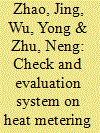

|
|
|
|
|
| Publication |
2009.
|
| Summary/Abstract |
Heat metering and energy efficiency retrofit of existing residential buildings in northern heating areas of China is organized and implemented in a large scale by local government in 15 provinces of North China with the unified guidance and control of central government. Firstly, this paper introduced the target of energy-saving reformation of existing residential buildings in North China and the importance of check and evaluation on this target, then pointed out the necessity of building up an evaluation system for energy-saving retrofit. According to the analytical hierarchy process (AHP), three-grade evaluation system was built up for heat metering and energy efficiency retrofit of existing residential buildings in northern heating areas of China. Also, based on multi-index comprehensive evaluation method combined with life cycle assessment (LCA) theory, post-evaluation thought and successful degree evaluation method, a mathematical model was established. Finally, a set of scientific method for evaluating heat metering and energy efficiency retrofit of existing residential buildings in northern heating areas of China systematically, scientifically, comprehensively and objectively was created.
|
|
|
|
|
|
|
|
|
|
|
|
|
|
|
|
| 2 |
ID:
089003
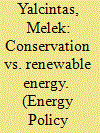

|
|
|
|
|
| Publication |
2009.
|
| Summary/Abstract |
State of Hawaii generates about 90 percent of its electricity from imported fossil fuel sources. Thus, there is pressure from both public and policy makers to reduce the State dependency on foreign fossil fuel sources. To this extend, there are incentives created at State and Federal level for both residential and commercial buildings to install photovoltaic (PV) systems. Although such incentives are necessary for long-term objectives, it is shown in this study that retrofitting inefficient old building-equipment is another viable source to reduce the State of Hawaii's electricity demand. Four case studies are presented to illustrate that building-equipment retrofitting is a viable and necessary tool for increasing the energy efficiency of buildings. Each case study presents an equipment retrofit project electricity savings with its payback periods, and compares with equivalent electricity capacity and economics PV systems in Honolulu, Hawaii. The case studies show that energy savings from retrofit projects ranged from 28% to 61% for individual equipment retrofits. These results indicate that equipment retrofitting with energy-efficient alternatives is about 50% or more cost-effective than installing PV systems. This is so even when large renewable energy tax incentives provided by the Federal and State Governments are taken into account.
|
|
|
|
|
|
|
|
|
|
|
|
|
|
|
|
| 3 |
ID:
088252


|
|
|
|
|
| Publication |
2009.
|
| Summary/Abstract |
This paper investigates the optimal choice of building energy efficiency (BEE) standard in the context of centralised urban district heating system in northern China. By employing a techno-economic analysis approach, we demonstrate that the current BEE standard implemented in the Chinese cities should be tightened further in order to achieve a socially optimal level. Without considering the externality costs associated with carbon dioxide (CO2) emissions, current BEE standards need to be upgraded to the equivalent level of French RT2005 standard coupled with a properly designed district coal-fired Combined Heat and Power (CHP). In contrast, the equivalent efficiency standard of Swedish building code is preferably to be implemented in the case of explicit carbon emission restriction as long as the marginal cost of carbon emission (carbon price) is sufficiently high. The fuel-switching policy (from coal to natural gas) in the urban district heating system would result in significant increase in overall costs if the BEE upgrade is not taken into account simultaneously. It is also found that BEE improvements in northern Chinese cities are more cost-effective than investing in low-carbon technologies such as wind power or Carbon Capture and storage in the EU and US with regard to CO2 emissions mitigation.
|
|
|
|
|
|
|
|
|
|
|
|
|
|
|
|
| 4 |
ID:
166342


|
|
|
|
|
| Summary/Abstract |
Energy performance certificates (EPC) were introduced in European Union to support reaching energy efficiency targets by informing actors in the building sector about energy efficiency in buildings. While EPC have become a core source of information about building energy, the domains of its applications have not been studied systematically. This partly explains the limitation of conventional EPC data quality studies that fail to expose the essential problems and secure effective use of the data.
|
|
|
|
|
|
|
|
|
|
|
|
|
|
|
|
| 5 |
ID:
137661
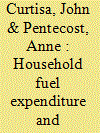

|
|
|
|
|
| Summary/Abstract |
This paper examines the relationship between residential buildings׳ energy efficiency labels and household energy expenditure, complementing an existing literature comparing theoretical and actual energy use. Residential building energy performance certificates indicate a theoretical energy use based on standardised assumptions about occupancy and energy service demand and are a market signal about the energy performance of a property. This paper quantifies the empirical relationship between households’ expenditure on fuel and building energy performance using household expenditure survey data from the Republic of Ireland. The extent of this relationship, i.e. the size of the elasticity parameter, is of direct relevance to policy makers in the context of energy efficiency and climate policy targets. With building energy efficiency measured as a 15-point scale, we find that each rating decline along the scale is associated with a reduction in energy expenditure of 1.6%.
|
|
|
|
|
|
|
|
|
|
|
|
|
|
|
|
| 6 |
ID:
088200
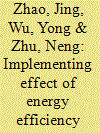

|
|
|
|
|
| Publication |
2008-09.
|
| Summary/Abstract |
The Chinese central government released a document to initiate a task of energy efficiency supervision system construction for government office buildings and large-scale public buildings in 2007, which marks the overall start of existing buildings energy efficiency management in China with the government office buildings and large-scale public buildings as a breakthrough. This paper focused on the implementing effect in the demonstration region all over China for less than one year, firstly introduced the target and path of energy efficiency supervision system, then described the achievements and problems during the implementing process in the first demonstration provinces and cities. A certain data from the energy efficiency public notice in some typical demonstration provinces and cities were analyzed statistically. It can be concluded that different functional buildings have different energy consumption and the average energy consumption of large-scale public buildings is too high in China compared with the common public buildings and residential buildings. The obstacles need to be overcome afterward were summarized and the prospects for the future work were also put forward in the end.
|
|
|
|
|
|
|
|
|
|
|
|
|
|
|
|
| 7 |
ID:
150006
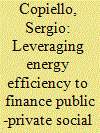

|
|
|
|
|
| Summary/Abstract |
The Italian housing model relies on a high rate of privately owned houses. In comparison, few dwellings are built and managed by the public sector. The social housing stock has been built mainly during some post-second world war decades; instead, since the early nineties, it underwent a privatization process.
|
|
|
|
|
|
|
|
|
|
|
|
|
|
|
|
| 8 |
ID:
111367


|
|
|
|
|
| Publication |
2012.
|
| Summary/Abstract |
With the increasing building energy consumption, the improvement of building energy efficiency (BEE) becomes a key part of the reduction of energy intensity in the "Eleventh Five-Year Plan" period (during 2006 and 2010) in China. For this reason, the China central government has enforced and implemented a series of policies to promote BEE. Based on the analysis of main characteristics of BEE development in China and developmental routes of BEE, this paper systematically explored six fiscal incentive policies. Meanwhile, four specific programs involving new building, existing residential building, government office building and large-scale public building, and applications of renewable energy in building were investigated. Besides, the key factors of BEE development and BEE developmental stages were analyzed. The research revealed the present progress of implementation on BEE policies, and identified the drawbacks of the present BEE mechanism. Moreover, four proposals were recommended to enhance the development of BEE in the next "Five-Year Plan" period.
|
|
|
|
|
|
|
|
|
|
|
|
|
|
|
|
|
|
|
|
|